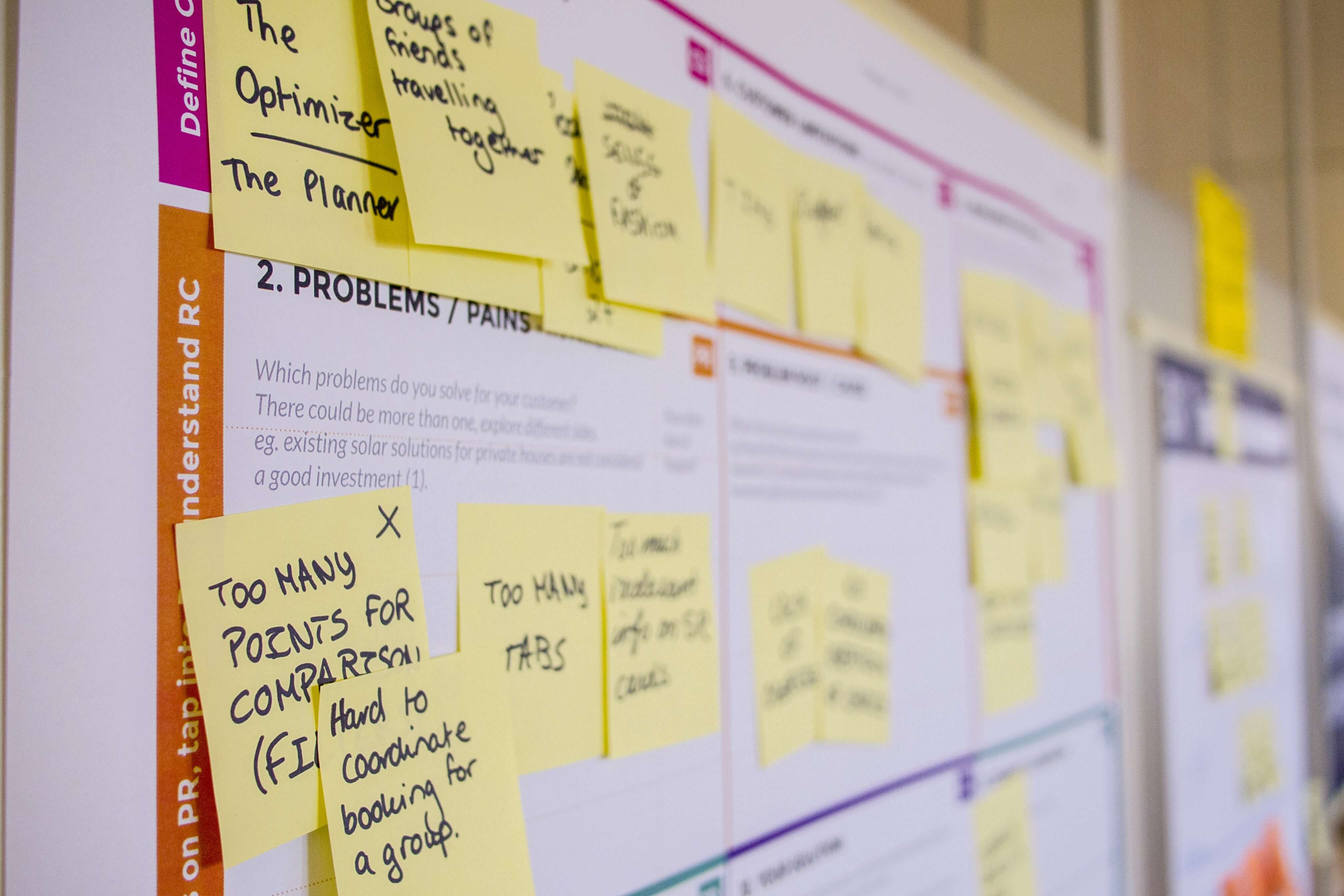Even if your business shows a stellar performance in the marketplace today, this may not be the case tomorrow. It isn’t uncommon for market leaders to fail to retain their vanguard simply because they fall behind in the innovation race. Investing in new product development backed up with in-depth market research can keep you relevant and even consolidate your reputation as a thought-leader in your industry.
Customers today are faced with what seems a limitless variety of products to choose from. One can purchase anything, from a robot vacuum to a Netflix subscription, and whatever the product, there’s always an army of competitor brands offering similar solutions. To stand out in this abundance and become the customer’s first choice, you should be developing new products that answer your target audience’s needs and exceed their expectations.
Even the smallest details can be the competitive advantage you need to reach another market segment and boost sales.
Continuously investing in new product development will help you secure steady growth, increase your revenue, and expand your audience.
Read on to find out how to do it, so that you can scale up your business and outshine the competition in the process.
What Is Product Development?
Product development, also referred to as NPD (New Product Development) is a process of designing and creating new products. It includes coming up with a concept idea, conducting market and pricing research, building and testing out a prototype, composing a marketing plan, and initiating production. NPD can also refer to updating and modifying existing goods in order to implement additional benefits to the customer.
The goal of new product development is to bring to the market solutions that provide value to people, make their lives easier, and satisfy their needs.
Idea Generation and Screening
Before you start developing a new product you should come up with prominent ideas that may benefit the market, and identify which of these have the potential for commercial success.
Idea Generation
Traditionally, in new product development, there are five officially acclaimed sources of innovation that elicit the ideas for new concepts, and set the wheels in motion.
- Technical Breakthrough. The advancement of technology makes it possible to build products that were unthinkable a few years before. Leveraging their knowledge, resources, and expertise, companies can invest in technological research and become pioneers in their field by coming up with completely new ideas. These can replace products that customers used to rely on to satisfy their needs, or respond to an entirely new set of needs.SaaS software, for example, was not possible before the invention of cloud computing, and cloud computing couldn’t have been developed before the widespread adoption of the internet, amongst other things.
- Non-Technical Idea Development. This approach utilizes the creativity of the company to conjure ideas that create a niche in the market no one else has thought of so far. It can be based on observation of the way customers use products in untraditional ways, or simply on coming up with a unique idea that the audience will find interesting.Take fingerboards, for example, those are tiny skateboards that you use your fingers to “ride”. Normal-sized skateboards were already around for over 30 years when in the ‘80s professional skateboarder Lance Mountain came up with the idea of making a miniature version of them and the kids went nuts. The idea is still popular today, 40 years later.
- Environment. Products that were developed in one environment or were considered native to a certain market alone, can be presented to a different target audience or under new circumstances, and reap success.For example, livestream shopping and TikTok were a hit on the Chinese market but were once completely unfamiliar to the rest of the world. And now enjoy worldwide popularity.
- Serendipity. Sometimes new product ideas can come by accident while you are doing research or developing a completely different product. Serendipity can be the best kind of innovation source, but unfortunately, it is not something you can control. However, it doesn’t hurt to stay alert to unexpected discoveries and look for ways to capitalize on them if they come your way.A good example of a serendipitous idea is how Coca-Cola was first made. It was invented by a pharmacist who was working on a headache medicine made of coca leaves and cola nuts. His assistant accidentally mixed the two with carbonated water, and the rest is history.
- Purposeful Development. When conducting market research, companies often encounter customer needs that the market is currently not satisfying. Those can be caused by changes in customer behaviors, alteration of the environment, or other factors. Whatever the cause, demand arises that is not met and businesses commence purposeful development to be the first to provide what the audience needs.A recent example of a similar situation is the 2020 pandemic when pharmaceutical companies were urged to develop an efficient vaccine that provides immunity to the Covid-19 virus.
Idea Screening
Once you’ve explored all potential sources and generated ideas of new products your company can develop, you should brainstorm them with a team of experts to identify which can be implemented, which should remain on hold, and which are no good at all.
Consider gathering an in-house team of specialists competent in different fields and representatives from any departments in your company that are relevant to product development.
Scrutinizing ideas from various angles including R&D, engineering, marketing, tech, financial, and sales perspective, will allow you to identify market opportunities that are both achievable and lucrative.
The goal of the idea screening phase of new product development is to eliminate concepts that are too risky or unreliable before you have invested any resources in them.
This can be done by comparing ideas to a checklist of technical, financial, and market requirements, and rating each of their assets on a scale.
While the specifics depend on the audience, the industry, and the type of product, some of the general questions businesses should consider are:
- Does the idea address prominent customer needs?
- Is the target market large enough to make production cost-effective?
- What is the target market growth potential?
- Is the product technically achievable?
- Does the company have the resources to develop the new product?
- Is production going to be cost-effective compared to the expected profits?
- What price the potential customer may be willing to pay?
Idea screening is an important part of product development and should be granted due time and consideration. Investing in a bad idea may cost companies money and resources, and discarding a good one can be a missed opportunity for business growth.
Once you’ve pinned down the ideas you want to implement, the next step is to develop the concept design.
Concept Design
New product development is a complex and risky endeavor but, as mentioned, if you play your cards right and rely on data-driven decision-making, it’s worth the effort. Delivering a novel solution to the marketplace should be planned and executed with the customer in mind, and, if possible, with their active participation. Otherwise, you risk wasting time, money, and resources to build a product no one needs or wants.
When outlining the design you should make extensive market research and focus on development opportunities that match the current trend in consumer or B2B buyer behavior. Adding predictive analytics to the mix will give you a better perspective of the landscape and provide valuable information that can be used in decision-making.
Know Your Audience

As we’ve already started discussing, your goal is to answer the needs of customers. To do so, you have to first discover these needs. You can start by gathering information about your ideal customers’ demographics, interests, behavioral patterns, pain points, media they follow, etc. This approach will help you come up with the psychographic profiles of your potential clients to turn them into ready-to-use buyer personas.
Another helpful way to find trends and understand what consumers’ are looking for in a product is to tap into their conversations through social media listening tools such as Reddit Keyword Monitor Pro, Hootsuite Syndicator, Reputology, and BrandWatch.
Conduct Voice of the Customer Research
Now that you know who your target audience is, you can focus on understanding them better and finding ways your product can be of service to them.
Voice of the customer (VOC) research is one of the most useful and powerful tools in new product development. It should be conducted in the initial stages of concept design and continuously updated in every next phase.
The goal of the study is to find out the customer’s needs, organize and structure them into a hierarchy of primary, secondary, and tertiary needs, prioritize their importance, and investigate the customer’s perception of the product.
The research planning and implementation should involve members of any departments involved in the production process, including R&D, development, design, engineering, sales, marketing, and so on. This team collaborates in conducting one-on-one interviews and focus group meetings with a sample of prominent clients, and asks them questions about their needs and preferences regarding different aspects of the product.
Leveraging the data from VOC research, companies can build solutions that perfectly match and even exceed the audience’s expectations. This insight into the customer’s understanding of the product and its value can be pivotal when the new product development team is faced with tough design and implementation decisions and compromises have to be made.
All in all, knowing the customer preferences and needs allows you to build the product they want, rather than one you assume they do.
Define the Product’s Purpose
Many companies focus on what they’re offering their customers, rather than why. However, while it’s vital to be on point with what problems your product helps people resolve, knowing why this is important to them will allow you to define the purpose of the solution you’re building and will help you align design, production, and marketing to perfectly fit the customer’s needs.
Choosing a purpose that’s inspirational and meaningful will power your innovation process and product development for years to come. Just think of Apple or Nike – it’s never been simply about the iPhone or the Nikes. In an age where competition is around every corner, the “Think Different” and “Just Do It” slogans are the “why” that inspire consumers to grow into brand ambassadors.
Collect Customer Insights

Researching your current market will help you retain your clients while securing your business growth. Existing behavioral patterns such as buying frequency, customer service interactions, content consumption, social media engagement, and so on, will present you with pertaining customer insights that can be incorporated in new product development.
For example, if most consumers are buying a new mobile phone each year, it makes sense to release new versions of such products annually and reach all of your potential clients without making unnecessary expenses.
People are sharing their opinions on any topic across countless communication channels, such as social media platforms, blogs, and recommendations addressed to their service provider or product developer. Their comments and feedback could give you valuable information about potential issues and challenges, market opportunities, user expectations, target market adjustments, and even the consumer’s purchasing power.
Defining the Product
Even the most carefully thought-through concept is still a work in progress. To become a finished product it should be polished out and tested in a real environment.
The goal is to see how users react to what you’ve come up with so far, and whether they would be willing to pay for it, and respectively, just how much they’d be willing to pay.
This can be determined with further investigation of your target market:
- Testing Prototypes. Building a limited edition of prototypes of the product concept will allow you to test how customers interact with it, what issues they encounter, how they feel about it, and, ultimately, what can be improved. Consider observing and recording the test so that you can analyze the results further and make them available to all relevant departments.
- Pricing Research. Initial pricing research should be done as soon as the idea screening and concept design stages of development in order to determine whether your product is cost-effective. However, once you have a clear idea of what the product will be and have built a prototype you should further investigate the subject and perform in-depth pricing research to determine the optimal price for your new solution.
- Brand and Marketing Research. Interact with potential customers and observe how they use the prototype, how they react to it, and what needs it helps them to satisfy. The insights you collect will be useful in building a marketing strategy for the product and better positioning it in the marketplace. It can also help you to design a relatable brand identity.
- Competitive Research. Competitors are a major factor in new product development and by researching their products and strategies you may acquire new ideas on how to remove possible flaws in your design, what features to add, and what overall improvements to make. Doing comparative competitor research will help you identify what you’re up against on the marketplace, understand your audience better, and come up with unique/key selling points that may accelerate moving customers down the funnel.
Collecting and analyzing data will help you define your final product and move on to the next stage.
Business Model

After you’ve completed the new product development process it’s time to find the best way to sell it. Whether it’s online, on TV, on mobile, in-store, through phone, social media, in partner networks, or all of the above, should be determined based on the information you’ve gathered in your research.
There are many different business models out there and which one you should choose depends on your product and the market. And if your innovation is unmatched in the marketplace and there is no existing business model that fits, inventing a new one will be another pioneering accomplishment. What’s important is that you should consider the approach that will best fit your customers and their needs, and focus your efforts there.
For example, if you’re a digital games reseller, and you’ve found out most of your potential clients shop online, there’s no need to invest in a store or to distribute your products in other brick-and-mortar shops. It’ll be much more cost-effective to use your website as a reselling platform, offer the ability to purchase downloadable versions of the games, as well as offer fast shipping for all products that may require it, such as merchandise.
Keep in mind that every product has a life cycle. Clothes are usually seasonal, mobile devices – annual, and some products like cars can be used for years. Whether the product belongs to a group that is new or is already declining in popularity may also affect both your marketing strategy and business model. Your goal should be to develop solutions with superior quality within the life cycle of your existing ones or build something completely new.
Marketing Your Product
Based on the profile of your ideal customer and the communication channels they prefer, you can design an omnichannel marketing strategy for your new product.
Insights from your research so far can be used to determine what content your audience best reacts to and what marketing message they may respond to. Also, knowing what their main challenges are and what needs the product helps them satisfy, will allow you to communicate the key benefits they may expect, and build a campaign they can relate to.
Your content strategy should incorporate formats for every stage of the marketing funnel, including blogging, social media posts, how-to-videos, white papers, ads, campaigns, articles, PR initiatives, and industry news.
Even if you create a cutting-edge innovation that customers can’t help but love, without advertising it the proper way and making people hear about it, you are doomed to fail. So make sure you design a smart marketing strategy or hire a professional agency to help you out.
Summary
In the constant race to innovate, introducing new products and modifying old ones to offer new or additional benefits for the consumer is vital to maintain your place in the market and secure a steady business growth.
To stand out from competitors and reach new market segments you have to do thorough research and use the gathered data to introduce new products and improve old ones to refresh their life cycle. Product development is a continuous process that requires constant innovation in the fight of becoming a market leader!





